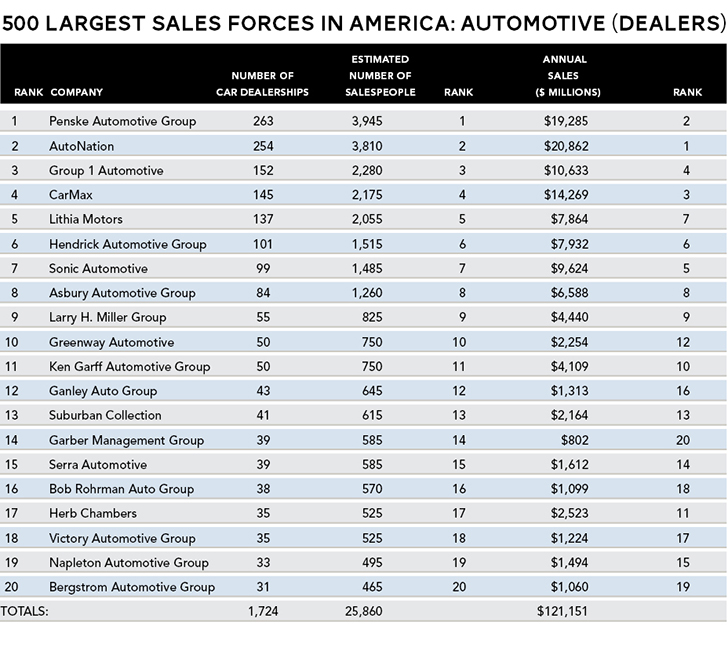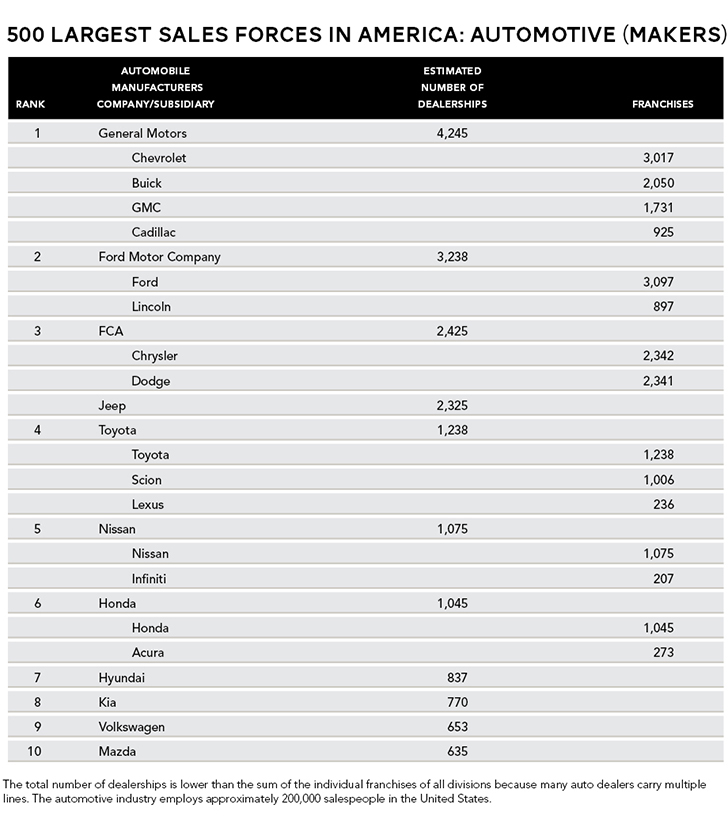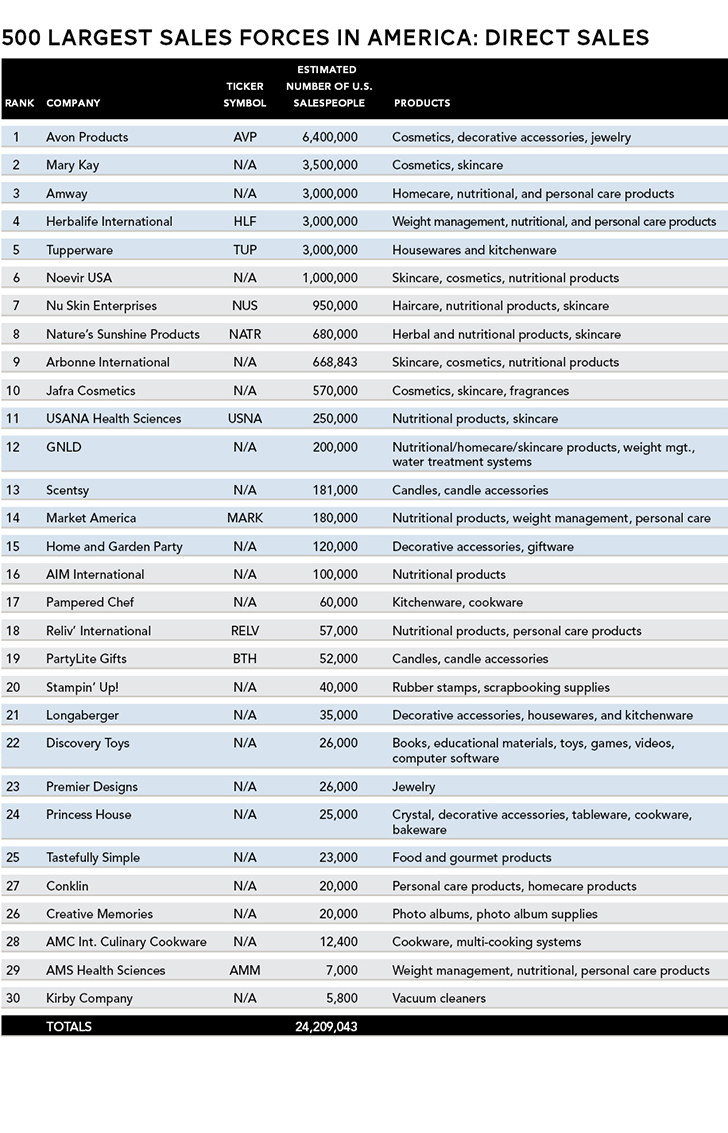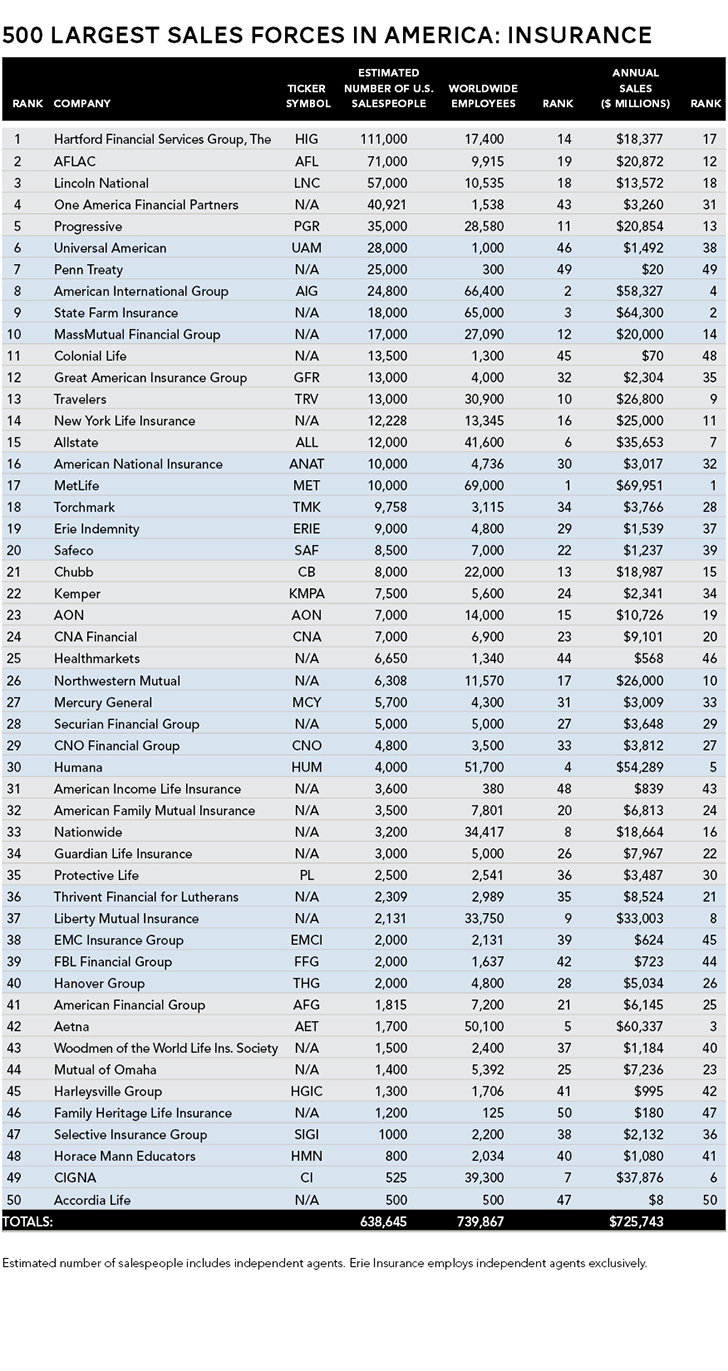New Webinar
The AI Science of Selling: How Smarter Segmentation Accelerates Revenue Growth
Tuesday, June 24th at 2:30pm ET.
Register Now!
To see Selling Power's most recently published Selling Power 500 listing, click here.
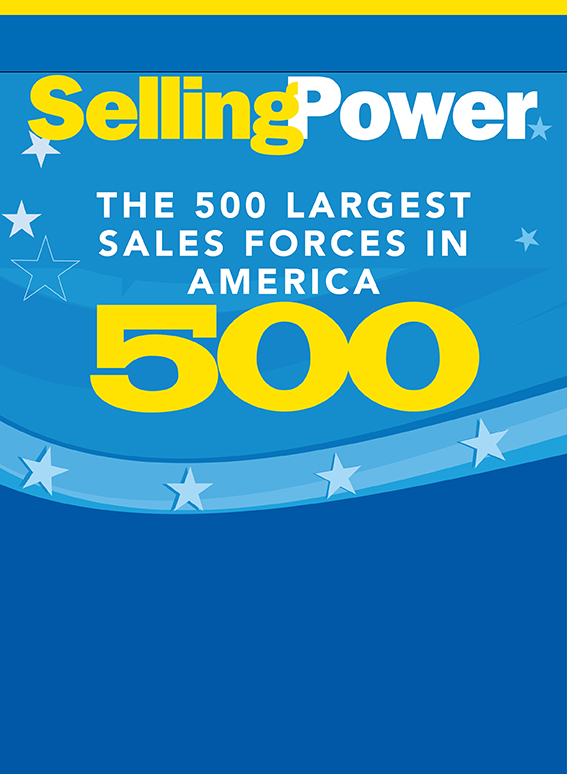
Every year, Selling Power magazine’s research team ranks companies according to the estimated number of salespeople they employ. The 500 top companies in America, which employ the world’s largest sales forces, depend on millions of salespeople to achieve their revenue goals, and this year marks the first time the number of salespeople is approaching the 26 million mark.
This shows that, without question, the men and women who make up each company’s sales force produce the revenue that will continue to fuel this country’s economy.
The 2016 SP 500 includes the top 200 companies in the manufacturing industry, the top 200 companies in the service industry, the top 50 insurance companies, the 30 largest direct-selling companies, and the top 20 automotive-dealer organizations (megadealers).
See the 2016 Selling Power 500 List:
Every year, new companies make the list while others drop off. The total number of salespeople employed by all 500 companies listed is 25,994,677, which represents a sizable increase of about 5 percent – or more than 1.1 million additional salespeople – as compared to last year. This overall change is due almost entirely to an increase in the number of salespeople working for direct-selling companies.
The direct-selling category, which posted a small 1 percent increase in 2015, posted a significant 5 percent increase this year – a possible indication that people are leaving the more traditional full-time sales force in greater numbers. The number of salespeople in the manufacturing industry increased by more than 6 percent, while the number of salespeople in both the service and insurance industries declined in 2016, by almost 3 percent and 1 percent, respectively. The decline in the service industry reversed the 3 percent increase in the number of salespeople posted last year. The automotive industry posted a small increase in the number of salespeople: up just over 2 percent. Overall, without the direct-selling numbers, the number of salespeople increased by a small 11,580 people, but continued a second straight year of increases.
The states with the most SP 500 companies are California (52), New York (50), and Illinois (36). The states in which the SP 500 companies employ the largest number of salespeople are New York (6,726,456), California (5,576,162), and Texas (3,768,240). These states account for about 27 percent of the total companies and a whopping 61 percent of the total salespeople.
Our research team continued to find that salespeople employed by manufacturing firms contribute a far higher amount of sales revenue than other industry segments. The top 200 manufacturing firms employ 521,041 salespeople and produce more than $3.8 trillion in sales. That’s an average of more than $7.4 million in sales per salesperson. This represents a significant (6 percent) decline in productivity compared to the previous year, which means productivity, which had been stagnant for three consecutive years, is now in decline. The number of manufacturing salespeople increased, gaining more than 32,000 salespeople compared to last year. The total number of manufacturing industry employees decreased slightly this year, decreasing by less than 1 percent from last year.
The top 200 companies in the service sector reported a small decrease of just more than 16,000 salespeople, bringing the total to 600,088 salespeople. The number of salespeople decreased by almost 3 percent, and the total revenue came in at more than $3.1 trillion, a 12+ percent increase over last year. This represents more than $5.2 million in sales per salesperson and a healthy 15 percent increase in productivity – now showing two straight years of productivity gains. The number of service-sector employees increased by just over 2 percent this year, making four consecutive years of increases in the number of service-sector employees.
The top 20 automotive megadealers reported positive numbers across the board this year. The top 20 firms own 1,724 dealerships (up by about 2 percent), employ an estimated 25,860 salespeople (an increase of about 2 percent), and produce more than $121 billion in sales (up by almost 4 percent). This brings the average annual sales per salesperson to almost $4.7 million (up by more than 1.7 percent). The productivity registered is a hopeful sign for an automotive industry that is continuing its recovery.
The top 50 insurance companies employ sales forces totaling 638,645 across the industry, with an average sales volume per salesperson of $1,136,379. This represents an insignificant increase in productivity of less than 1 percent. In fact, the number of salespeople declined slightly from last year (a less than 1 percent drop), while their productivity remained relatively unchanged. The total number of employees posted a decrease of more than 6 percent from 2015.
The top 30 direct-selling companies reported more than 24 million salespeople, continuing a trend of increases in the number of salespeople in this industry within the past 15 years. This year’s large increase in the number of salespeople is one of the industry’s largest annual increases in the past six years.
Overall, the numbers illustrate an overall stagnant workforce, declining employment and productivity in the manufacturing sector, and a service sector that, while gaining in productivity, is declining in the number of salespeople. Outside of the direct selling industry, the total number of salespeople remained relatively flat – as did the number of employees. The revenue generated per salesperson increased across every industry apart from the manufacturing industry.
Each salesperson in the service or manufacturing industry supports, on average, 13.71 other jobs within the company; that figure marks a small decrease from last year’s number of 13.82 and is the first such decrease we have reported. These companies employ a total sales force of more than 1.1 million salespeople, who produce more than $6.9 trillion in sales and ensure the employment of more than 16 million people. This underscores the fact that the sales forces of America are responsible for helping sustain and ensure our economy’s future growth.
TOP EXECUTIVES – Use the SP 500 to benchmark your company’s productivity per salesperson. Find out how you measure up to your competition and the average in your industry. Check which companies have decreased their sales forces and which are gearing up for expansion.
SALESPEOPLE – Use the SP 500 as your best-prospect list. There is no other source that gives you access to those companies that purchase products for a large number of salespeople. This is your ideal list if you sell sales training, sales-incentive services, customer relationship management solutions, automotive fleets, sales meetings, or trade show services. Begin your account planning by researching company Websites.
JOB SEEKERS – Use the SP 500 to plan your sales career. These 500 companies employ the largest sales forces in America. Large companies invest heavily in recruiting, training, and rewarding sales staff. To find job openings, log onto the companies’ Websites.
EDUCATORS – Use the SP 500 as a tool to build next year’s curriculum. Every year, SP 500 companies seek to recruit more than 500,000 college graduates. There are more than a dozen colleges that offer sales curricula, and all of their graduates can look forward to solid careers in sales. Prepare your future students for a lucrative career in sales. (Note: media research shows that the average Selling Powermagazine reader has a college degree, works in sales management, and has a household income of more than $174,000 per year.)
Special thanks go to our corporate research team for collecting the data. To have your company listed in the Selling Power 500 next year, please email research@sellingpower.com.
